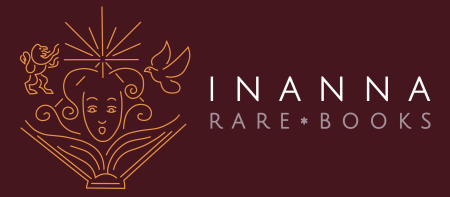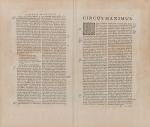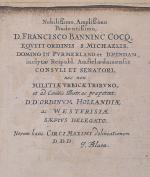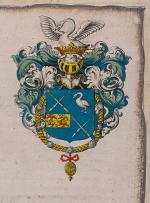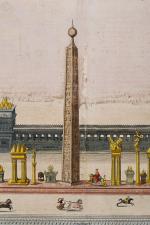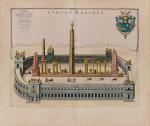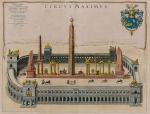Blaeu, Circus Maximus.
Circus Maximus.
Original hand-coloured engraving. Amsterdam, J. Blaeu, [c.1663]. Plate Size: 55 cm x 42 cm. Sheet Size: 64.5 cm x 55 cm. Original map. In very good condition. Very minor traces of browning to outer margins. Latin text on reverse.
[From Atlas van Loon – Volumes X, XI and XII: Blaeu’s city books of Italy, covering the Papal States, Rome, Naples, and Sicily, all of 1663. Frederik Willem van Loon commissioned the Atlas, which consisted of a large number of maps published between 1649 and 1676. (Source: ‘The Memory’ database from Koninklijke Bibliotheek / Dutch National Library.]
An attention-grabbing illustrated re-imagining of Rome’s Circus Maximus, the city’s largest hippodrome. Its principal function was as a chariot racetrack and host of the Roman Games (Ludi Romani) which honoured Jupiter. The racecourse and arena had a capacity ranging between 150,000 spectators, in the era of Julius Caesar, to 250,000, after it was enlarged in the 4th Century AD by the Emperor Constantine. Though in decayed ruins by the time of this engraving, the Circus Maximus is stunningly recaptured in its ancient splendour and Imperial pomp.
The main features of the Circus Maximus can be seen: the decorated barrier (spina or euripus) complete with two obelisks dedicated to the sun and the moon (possibly the Lateran and Flaminio obelisks), which were later removed by Pope Sixtus V, and numerous statues and ornamental structures are shown running down the centre of the track. Tripartite conical turning posts (metae) are placed at each end of the track. Golden statues adorn the outer walls of the stadium. Four galloping riders and horses are seen on the racetrack, followed by three three-horse chariots.
A large, highly decorative armorial coat-of-arms is located in the top right corner. Top left corner shows explanatory/titular text that references Frans Banninck Cocq, a burgemeester (mayor) of Amsterdam in the mid-17th century. He is best known as the central figure in Rembrandt’s masterpiece The Night Watch.
Willem Janszoon Blaeu (1571-1638) was a Dutch cartographer, atlas maker and publisher. Along with his son Johannes Blaeu, Willem is considered one of the notable figures of the Netherlandish/Dutch school of cartography in its golden age (the 16th and 17th centuries). Blaeu set up his mapmaking and publishing business in Amsterdam, where he sold instruments and globes, published maps, and edited the works of intellectuals like Descartes and Hugo Grotius. In 1633 he was appointed map-maker of the Dutch East India Company. In 1635, he released his atlas, Theatrum Orbis Terrarum, sive, Atlas novus.
Willem died in 1638. He had two sons, Cornelis (1610-1648) and Johannes (1596-1673). Joan trained as a lawyer but joined his father’s business rather than practice. After his father’s death, the brothers took over their father’s shop and Joan took on his work as hydrographer to the Dutch East India Company. Later in life, Joan would modify and greatly expand his father’s Atlas novus, eventually releasing his masterpiece, the Atlas maior, between 1662 and 1672. (Wikipedia)
- Keywords: Ancient Rome · Antiquities · Antiquity · Catalogue Four – International Art · Europe · Original Artwork Rare · Original Decorative Art Rare · Original Engraving · R & B · Rare Map – Italy · Rome · Travel Europe – Rare · Travel Italy – Rare · Vintage
- Inventory Number: 200057AG
EUR 1.400,--
© 2024 Inanna Rare Books Ltd. | Powered by HESCOM-Software
